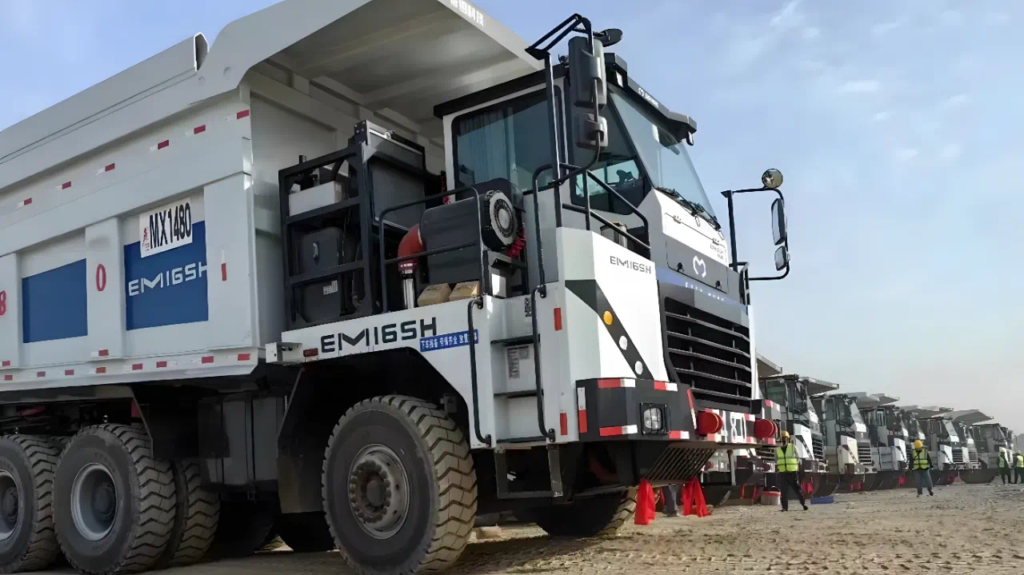One of the many Chinese companies looking to grab a piece of the action when it comes to next generation mining trucks is Iridium Molybdenum Technology, full name Xiamen Yimu lntelligence Technology Co Ltd, which uses the slogan EASYMOVE.
Iridium Molybdenum Technology’s initial model is the 115 ton class EM165H, equipped with a Guangxi Yuchai 16L YCK16775 engine and 108 kW lithium manganate battery. Recently, the first 10 EM165H trucks were delivered to the Baishihu open pit coal mine in Hami, Xinjiang, which is operated by Yiwu Guanghui Mining Co Ltd.
According to the Xinjiang Uygur Autonomous Region’s Emergency Management Department, the mine’s production capacity has increased from 18 Mt per year to 35 Mt per year hence the drive for larger class trucks. The delivery of these vehicle marked an important step in the commercial evolution of Iridium Molybdenum Technology. In tests, the EM165H has been shown to be still capable of driving on a 28% slope gradient even when overloaded to 150 t.
The company is also set to introduce its larger EM186H 130 ton wide body hybrid mining truck at the forthcoming Bauma China event in Shanghai from November 26-29, 2024. The new truck uses a Chinese Guangxi Yuchai 16L YCK16775-T30 1,900 kW engine with 118 kWh lithium manganate battery, 8DS260 transmission, auxiliary AMT E-drive and 400 kW drive motor.
The trucks are part of a multi-bridge, new energy mining truck platform, which it calls HiMADS, consisting of new large-scale wide body trucks, with multiple energy combination modes. The platform also adopts multi-axis drive front and rear multi-axis steering technology, where the front and rear multiple axes can steer intelligently and collaboratively, making the vehicle’s turning radius smaller and more flexible. It also means that the vehicles with upgraded load capacity can still easily adapt to the existing transportation roads in the mining area.
It states: “Iridium Molybdenum Technology’s multi-axis drive technology solution uses a distributed drive method to disperse the vehicle load, which not only makes the load-bearing more balanced, but also reduces the requirement for large-scale single components.” The 8×6 configuration offers full hydraulic, two axle steering with the first and fourth axles being the steering axles. HiMADS it says can be customised and equipped with a variety of drivetrain forms, not only the standard diesel engine + battery hybrid but also pure electric drive, methanol extended range, and hydrogen.
It adds: “HiMADS integrates intelligent control and a modular hybrid power system, which can reasonably allocate power output according to working conditions, achieving very good energy-saving effects. The intelligent energy-saving system uses intelligent algorithms to reduce process losses, provide energy-saving driving tips, downhill braking energy recovery and charging, etc ensuring that even under the worst working conditions, the vehicle can still save more than 20% more energy than mainstream fuel vehicles currently on the market.”
HiMADS is equipped with a power coupling and intelligent power management system. “As the ‘brain’ of the power system, it can not only flexibly allocate power to each axis, but also adapt to various needs such as uphill and downhill, unloading, and escape, thus having better climbing ability. and load capacity, it can also accurately identify operating conditions and adopt different output strategies, while improving the vehicle’s power and economy.”
Given that the power and steering systems of the HiMADS platform are more complex, the requirements for intelligence and networking are higher. Therefore, a multi-controller domain control architecture is adopted to adapt to higher control requirements. This architecture divides functions into four domains: power domain, chassis domain, cockpit domain, and autonomous driving domain. Each domain is connected to the central gateway to improve collaboration capabilities and intelligence levels.
In addition, HiMADS also has an intelligent network connection system. It collects vehicle operating data in real time through the 4G/5G network, including vehicle speed, fuel consumption, camera images and voice and other data, and realises vehicle operation through synchronous analysis including remote diagnosis, maintenance and other functions. At the same time, the data platform can realise the management of the fleet, view the real-time location of each vehicle and other information in real time, conduct dispatching and command of the fleet, and improve the dispatching efficiency and fleet informatisation capabilities.
The company adds on autonomy: “HiMADS will continue to be upgraded and iterated. With the application of wire-controlled chassis and domain controller technology, it will become a mining truck platform more suitable for carrying unmanned driving technology. At the same time, the platform adopts a modular design…customers can freely customise models according to the mining area environment and development requirements like building blocks, and quickly realise iterative upgrades of manned and unmanned driving.”











